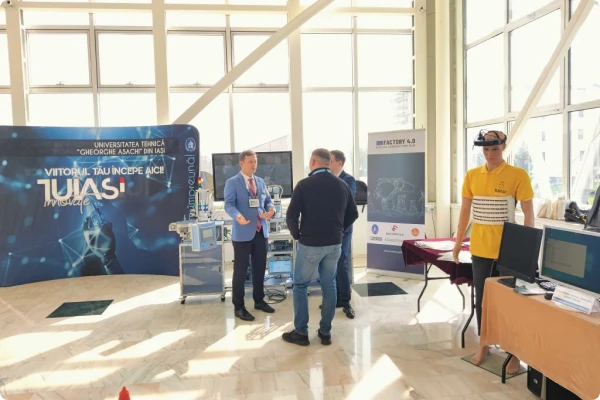Test before invest
With the help of XR* technologies, a variety of business operations in different industries can be improved, including in the area of training, collaboration, remote assistance and more.
*XR Technologies: Augmented Reality (AR), Virtual Reality (VR) and Mixed Reality (MR).
The Hub’s XR experts can help you discover the various benefits that AR, VR and MR technologies can bring to your organization through research, proof-of-concept and innovative solutions. We can help you look beyond the 2D world so you can better manage your assets, increase your productivity and improve your customer experience.


In this field we have implemented a neuromotor recovery system (post-stroke, brain trauma or brain surgery) for the upper limbs that can be used both in the early and in the advanced stage of customizable recovery, capable of integrating the multitude of forms of physical support and automated feedback. It is based on virtual reality (VR), brain computer interface and functional electrical stimulation.
According to the World Health Organization (WHO), stroke affects approximately 13.7 million people annually. It is the third leading cause of long-term disability, with approximately 60% of survivors left with dysfunctional sequelae, particularly in the upper limbs and with reduced mobility. Research over the last 15 years highlights the fact that intense, repeated and focused training, started as soon as possible after stroke, supports the relearning of lost functions, based on neuroplasticity.
Neuromotor recovery is a training/learning cycle with the following components running quasi-parallel:
All 3 of these elements: trying/performing the act, observing, and association/refinement at the cortical level are essential in recovery.
We perform an implementation for the manual control and monitoring of operating parameters of a fleet of mobile, autonomous, omnidirectional robots using the Hololens2 mixed reality (MR) system.

The proposed system consists of the brain-computer interface, a VR system and a neurostimulator for the recovery of neuromotor functions both in stroke patients and in patients with other neurological deficits. This system helps the patient regain motor functions and movements of the upper and lower extremities, with results ranging from decreased pain, spasticity, tremors, to improved concentration, motor movements, passive joint movements, sensitivity and gait.
The system combines mental activities with neuromotor functions, eliminating the disadvantage of inability to move the limbs caused by a neurological disorder.
While working with this system, patients are seated approximately one meter in front of a monitor. They are instructed to imagine a hand or leg movement. Once the system successfully recognizes the imagined movement, the virtual reality avatar will perform the imagined movement and the neurostimulator will induce through functional electrical stimulation (FES) the actual movement of the limb in question.
By integrating post-stroke rehabilitation services based on BCI and FES a unique selling proposition can be created. The system can be rented or purchased. Regarding the valorization of the services, the calculation can be done as follows: during one day, approximately 6 recovery sessions can be performed with a single system at a price of 50 euros per session. It follows that in one month (20 working days), the company’s gross income would be 6000 euros in one month. Of this amount, 1200 euros represent the loan rate/rent of the equipment, 2200 euros salary expenses, 1100 euros consumables, energy and other taxes and the remaining 1500 euros represent the company’s gross profit per equipment.